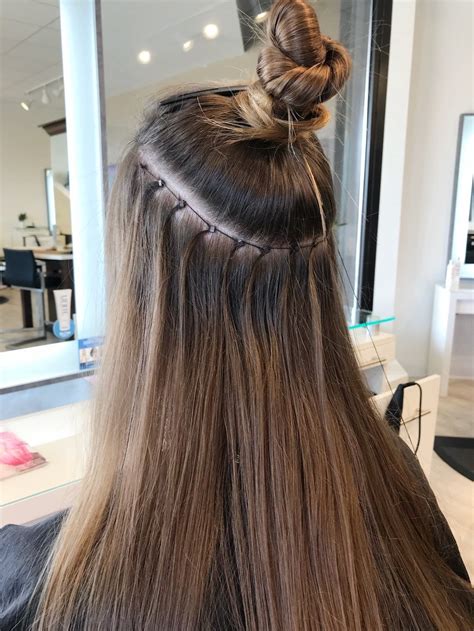Introduction
Hair extensions have become a popular way to enhance the length, volume, and style of one’s natural hair. They offer a versatile and effective solution for achieving a variety of hair goals, from subtle enhancements to dramatic transformations. This article delves into the world of hair extensions, exploring the different types, benefits, and techniques involved in natural hair integration.

Types of Hair Extensions
There are numerous types of hair extensions available, each with its unique characteristics and benefits. The most common types include:
Clip-In Extensions
Clip-in extensions are temporary extensions that can be easily attached and removed. They come in various lengths, colors, and textures, allowing for customization. Clip-in extensions are a convenient and affordable option for occasional use.
Tape-In Extensions
Tape-in extensions are semi-permanent extensions that are applied using a thin, double-sided tape. They are flat and lightweight, creating a seamless blend with natural hair. Tape-in extensions last for 6-8 weeks and can be reused multiple times.
Sew-In Extensions
Sew-in extensions are permanent extensions that are sewn directly into natural hair using a needle and thread. They offer a strong and secure hold, allowing for longer-term wear. Sew-in extensions can last up to 3 months and can be styled as desired.
Bonded Extensions
Bonded extensions, also known as fusion extensions, use heat to bond individual strands of hair extensions to natural hair. They come in various methods, including keratin, tape, and glue bonds. Bonded extensions provide a long-lasting solution with minimal damage to natural hair.
Benefits of Hair Extensions for Natural Hair
Hair extensions offer numerous benefits for those looking to enhance the appearance and health of their natural hair:
- Length and Volume: Extensions can add instant length and volume, creating the appearance of fuller, thicker hair. This is especially beneficial for individuals with fine or thinning hair.
- Color and Highlights: Extensions can add highlights or color streaks without the need for chemical treatments, allowing for experimentation with different shades.
- Protective Styling: Extensions can protect natural hair from heat damage caused by styling tools and environmental factors. By providing an extra layer of protection, they can prevent breakage and split ends.
- Versatile Styling: Extensions offer endless styling possibilities, from elegant braids to chic updos. They allow individuals to explore different hairstyles without altering their natural hair.
Choosing the Right Hair Extensions
Selecting the right hair extensions is crucial for a seamless and natural-looking result. Consider the following factors:
- Hair Type: Choose extensions that match your natural hair type (straight, wavy, curly) to ensure a cohesive blend.
- Hair Color: Opt for extensions that closely match your natural hair color or experiment with subtle highlights to enhance dimension.
- Length and Volume: Determine the desired length and volume you want to achieve and select extensions accordingly.
- Budget: Consider the cost of the extensions, including the installation and maintenance.
- Lifestyle: Choose extensions suitable for your lifestyle, whether it involves regular styling, swimming, or physical activity.
Professional Installation and Maintenance
Professional installation is essential for achieving a natural and seamless look. A skilled stylist will assess your hair type and goals and select the most appropriate extensions and application method.
Regular maintenance is crucial to ensure the longevity and health of your hair extensions. This includes regular brushing, washing, and conditioning. Follow the stylist’s instructions and use products specifically designed for extensions.
Cost of Hair Extensions
The cost of hair extensions varies depending on the type, length, volume, and installation method. Here is a general cost range:
| Type of Extension | Price Range |
|---|---|
| Clip-In Extensions | $50-$200 |
| Tape-In Extensions | $200-$500 |
| Sew-In Extensions | $300-$800 |
| Bonded Extensions | $500-$1200 |
FAQs
-
Can I wash and style my hair extensions?
Yes, you can wash and style your hair extensions just like your natural hair. Use products specifically designed for extensions and avoid heat damage. -
How long do hair extensions last?
The lifespan of hair extensions depends on the type and care. Clip-in extensions can last a few months, while semi-permanent and permanent extensions can last several months to a year. -
Do hair extensions damage my natural hair?
When installed and maintained properly, hair extensions should not damage natural hair. However, it’s important to choose the right type of extensions and avoid excessive tension or heat styling. -
Can I get hair extensions on short hair?
Yes, it’s possible to get hair extensions on short hair. Clip-in and tape-in extensions are suitable options, as they can be applied without the need for length or volume. -
How can I prevent hair extension tangles?
Regular brushing and detangling with a wide-toothed comb will help prevent tangles. Use a leave-in conditioner or detangling spray to reduce friction and keep extensions smooth. -
Can I swim with hair extensions?
Swimming in chlorine or salt water can damage hair extensions. It’s recommended to avoid swimming or use a swimming cap to protect them.
Conclusion
Hair extensions offer a transformative solution for those looking to achieve beautiful, healthy, and versatile hair. By choosing the right type of extensions, working with a skilled stylist, and following proper care instructions, you can enjoy the benefits of enhanced hair without compromising the health of your natural hair. Embrace the endless possibilities and let hair extensions empower you to express your style with confidence.
